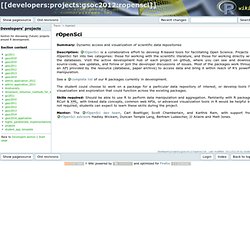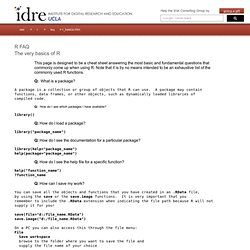

NelsonMinar/vector-river-map. Tutorials. Gbif.org: Home Page. Welcome — Big Data DS. Natural Capital Project - InVEST. InVEST is a suite of software models used to map and value the goods and services from nature that sustain and fulfill human life.

If properly managed, ecosystems yield a flow of services that are vital to humanity, including the production of goods (e.g., food), life-support processes (e.g., water purification), and life-fulfilling conditions (e.g., beauty, recreation opportunities), and the conservation of options (e.g., genetic diversity for future use). Despite its importance, this natural capital is poorly understood, scarcely monitored, and, in many cases, undergoing rapid degradation and depletion. InVEST enables decision makers to assess quantified tradeoffs associated with alternative management choices and to identify areas where investment in natural capital can enhance human development and conservation.
The toolset currently includes sixteen distinct InVEST models suited to terrestrial, freshwater, and marine ecosystems. Developers:projects:gsoc2012:ropensci. Summary: Dynamic access and visualization of scientific data repositories Description: rOpenSci is a collaborative effort to develop R-based tools for facilitating Open Science.

Projects in rOpenSci fall into two categories: those for working with the scientific literature, and those for working directly with the databases. Visit the active development hub of each project on github, where you can see and download source-code, see updates, and follow or join the developer discussions of issues. Most of the packages work through an API provided by the resource (database, paper archive) to access data and bring it within reach of R’s powerful manipulation.
See a complete list of our R packages currently in development. The student could choose to work on a package for a particular data repository of interest, or develop tools for visualization and exploration that could function across the existing packages. Introduction to Programming and Database Management for Biologists. Syllabus | Schedule | Assignments | Lectures Instructor: Dr.

Ethan White (ethan.white@usu.edu) Course Content: Computers are becoming increasingly essential to the study of all aspects of biology. Basic computer programming and database management are now required for everything from accessing, storing and managing data, to statistical analysis, to simulation and numerical modeling.This course will provide an introduction to computer programming and database management targeted towards biologists, and will take a student-centered, active learning, approach to teaching this material. Class will typically consist of a short introductions to programming/database techniques and associated biological problems, followed by hands on computing exercises.
Ecological Data Wiki. Education Modules. Rocky Mountain Biological Laboratory. Home. The Green Algae Tree of Life (GrAToL) is a project involving the collaboration of five institutions to understand the evolutionary relationships of all of the major groups of green algae, a diverse group of more than 14,000 photosynthetic species worldwide. Green algae are abundant and play important roles in a wide variety of terrestrial and aquatic habitats, including deserts, extremely salty ponds, and coral reefs, and several species are symbiotic partners with lichens and animals. Thus, green algae are important primary producers in most ecosystems. Green algae are diverse in form - from microscopic single cells to large seaweeds - and function as important primary producers in most ecosystems.
The project will employ DNA sequence data to assemble a tree of life reflecting the evolutionary history of the group. Tropical Native Species Reforestation Information Clearinghouse (TRIC) LigerCat. OntoSpecies - exploring the Biology of Aging through ontologies. All Organisms from 1750 to 2000 - Taxatoy. uBio Home. R FAQ: The very basics of R. R FAQ The very basics of R This page is designed to be a cheat sheet answering the most basic and fundamental questions that commonly come up when using R.

Note that it is by no means intended to be an exhaustive list of the commonly used R functions. Q: What is a package? A package is a collection or group of objects that R can use. A package may contain functions, data frames, or other objects, such as dynamically loaded libraries of compiled code. Q: How do I see which packages I have available? Library() Q: How do I load a package? Library("package_name") Q: How do I see the documentation for a particular package? Library(help="package_name") help(package="package_name") Q: How do I see the help file for a specific function? Help("function_name") ? Q: How can I save my work? You can save all the objects and functions that you have created in an .RData file, by using the save or the save.image functions. Q: How can I retrieve the work that I have saved using a save.image function? Objects() ls()
Catalogue of Life - 3rd February 2012. Citizen science. This article or section is incomplete and its contents need further attention.

Some sections may be missing, some information may be wrong, spelling and grammar may have to be improved etc. Use your judgment! Work on this piece started on January 2012. It includes some rough literature review on chosen topics, in particular with respect to topics like "how do participants learn", "in what respect are citizens creative", "what is their motivation", "how do communities work". In other words, this article is just a "note taking" piece and it should be revised some day ... Ballona Historical Ecology. The EOL Biodiversity Synthesis Group. The iPlant Collaborative: Empowering a New Plant Biology. HIP - Evoio. NESCent: The National Evolutionary Synthesis Center.